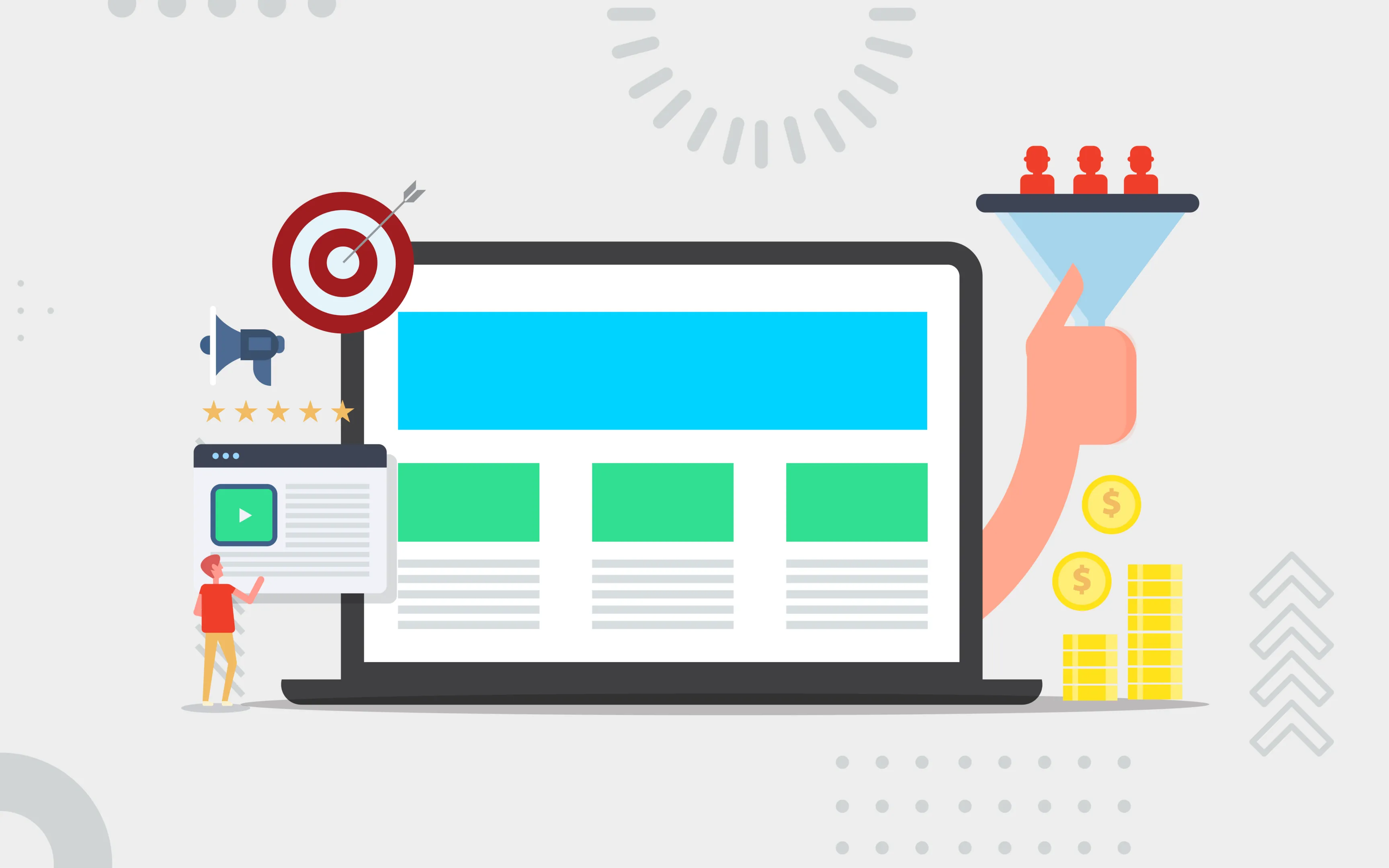What is Sales Prospecting?

Sales prospecting is the process of finding potential customers for your product or service, much like searching for treasure. It is sales prospecting, important to identify people who might be interested in what you are selling.
Why Sales Prospecting is Important in the Sales Process?
Sales prospecting is important because it helps you find new customers. Without new customers, your business cannot grow.
Here are the reasons as to why it is important:
1. Filling the Sales Pipeline
For instance, think of your marketing department and sales process as a pipeline. To keep it full, you have to new leads constantly. Prospecting helps you do that. It ensures you always have potential buyers to contact.
The sales funnel helps you visualize the journey of prospects from initial contact to sales qualified leads to becoming paying customers.
- According to HubSpot, 42% of sales reps say prospecting is the hardest part of the sales process.
- This step is crucial for maintaining a steady flow of sales prospects.
- Sales rep play a crucial role in identifying and nurturing potential customers.
2. Identifying Qualified Leads
Not everyone will buy your product. Prospecting helps you find people who are more likely to be interested. These people are called qualified leads. When you focus on qualified leads, you save time and effort.
- A study by MarketingSherpa found that 61% of B2B marketers send all leads directly to sales, but only 27% of those leads are qualified.
- This means targeting qualified leads makes your sales process more efficient.
3. Building Relationships with Potential Customers
Prospecting is not just about selling; it’s about building relationships. When you reach out to potential customers, you start a conversation. Over time, this can turn into trust. Trust is essential for sales.
- Sales professionals believe that building trust with potential buyers is the most important factor in making a sale.
- This trust can lead to long-term customer relationships.
4. Understanding Customer Needs
When you begin prospecting, you learn about your customers' needs and pain points. This information is valuable. It helps you tailor your sales pitch to show how your product can solve their problems.
- According to Salesforce, 79% of business buyers say it's very important to interact with a salesperson who is a trusted advisor.
- Understanding needs makes your pitch more relevant and persuasive.
5. Staying Ahead of Competitors
By constantly finding new prospects, you stay ahead of competitors. You reach potential customers before they do. This can give you a big advantage in the market.
- Identifying sales prospect early on can give you a competitive edge.
- A report by McKinsey shows that companies with advanced sales capabilities are 1.4 times more likely to achieve above-average growth rates.
- Early engagement can secure customer interest before competitors.
15 Innovative and Effective Strategies for Sales Prospecting Process
Developing effective sales prospecting strategies can significantly enhance the sales cycle and improve your sales performance.
1. Leverage LinkedIn Sales Navigator for Targeted Outreach

Why It's Important:
LinkedIn Sales Navigator is a powerful tool for finding potential customers. It helps you target specific people who might be interested in your product or service. Using LinkedIn Sales Navigator can increase your chances of success in sales prospecting.
How to Implement:
Set Up Your Account:
- Sign up for LinkedIn Sales Navigator and set up your profile.
- Make sure your profile is complete and professional.
- Example: Profiles with a professional photo are 14 times more likely to be viewed.
Use Advanced Search:
- Use the advanced search feature to find potential customers.
- You can search by industry, job title, location, and more.
- Example: If you sell software to schools, you can search for "IT managers in schools."
Save Leads:
- Save the profiles of people who match your criteria.
- This helps you keep track of potential customers.
- Example: Save leads into different lists based on their potential interest levels.
Send Personalized Messages:
- Reach out to your saved leads with personalized messages.
- Mention something specific about their profile to show you did your research.
- Example: "Hi [Name], I noticed you manage IT at [School]. We offer software that can help improve your network security."
Follow Up:
- Follow up if you don't get a response. Sometimes, people need a gentle reminder.
- Example: "Hi [Name], I wanted to follow up on my previous message about our software. Do you have any questions?"
Using LinkedIn Sales Navigator can make your sales prospecting more efficient and effective. It helps you find the right people and connect with them in a professional way.
2. Implement Multi-Channel Sales Prospecting Techniques

Why It's Important:
Using multiple channels for sales prospecting increases your chances of reaching potential customers. Different people prefer different ways of communication. By using various channels, you can connect with more potential customers and increase your sales pipeline.
How to Implement:
Identify Channels:
- Identify the channels where your potential customers are most active.
- Common channels include email, phone calls, social media, and direct mail.
- Example: 70% of customers prefer to be contacted by email.
Create a Plan:
- Create a plan for how you will use each channel.
- Example: Start with an introductory email, follow up with a phone call, and then connect on LinkedIn.
Craft Personalized Messages:
- Craft personalized messages for each channel.
- For email, you could write, "Hi [Name], I noticed you are interested in [Topic]. We have a product that can help you with [Benefit]."
- Example: For phone calls, say, "Hello [Name], I wanted to follow up on the email I sent about our product."
Use Tools:
- Use tools to help manage your prospecting efforts.
- CRM software can assist you in managing and tracking your interactions with potential customers.
- Example: Use email marketing tools to send personalized emails at scale.
Measure Results:
- Measure the results of your prospecting efforts.
- Track which channels are most effective and adjust your strategy accordingly.
- Example: If most responses come from social media, focus more on that channel.
3. Host Webinars and Attend Networking Events

Why It's Important:
Hosting webinars and attending networking events are great ways to meet potential customers and build relationships. These events let you showcase your expertise and connect with people who are interested in what you offer.
How to Implement:
Plan Your Webinar:
- Choose a topic that interests your potential customers. Make sure it solves a problem they have.
- Example: If you sell marketing tools, host a webinar on "Top 5 Marketing Strategies for 2024."
Promote Your Webinar:
- Use social media channels, email marketing, and your website to promote your webinar.
- Example: Share posts on LinkedIn and Twitter, and send emails to your leads.
Engage During the Webinar:
- Interact with your audience by asking questions and encouraging participation.
- Example: Use polls and Q&A sessions to keep the audience engaged.
Follow Up:
- After the webinar, send follow-up emails to thank attendees and offer additional resources.
- Example: "Thank you for attending our webinar! Here are some free resources to help you implement the strategies we discussed."
Attend Networking Events:
- Research and attend events where your potential customers will be.
- Example: Attend industry conferences, trade shows, and local business meetups.
Prepare Your Pitch:
- Have a clear and concise pitch ready for when you meet potential customers.
- Example: "Hi, I'm [Your Name] from [Your Company]. We help businesses like yours improve their marketing strategies with our tools."
Collect Contacts:
- Exchange business cards and connect on LinkedIn with people you meet.
- Example: "I'd love to connect with you on LinkedIn and continue this conversation."
Hosting sales meetings, webinars and attending networking events can expand your network and help you find qualified leads.
4. Craft Personalized Sales Pitches for Each Prospect

Why It's Important:
Personalized sales pitches show potential customers that you understand their needs and are offering a solution just for them. This personalized pitch also increases the chances of turning prospects into paying customers.
How to Implement:
Research Your Prospects:
- Gather information about your prospects’ businesses, challenges, and goals.
- Example: Use LinkedIn Sales Navigator to learn about your prospect’s role and their company’s focus.
Identify Pain Points:
- Understand the specific problems your prospects face.
- Example: If a prospect struggles with lead generation, focus your pitch on how your product helps generate leads.
Customize Your Pitch:
- Tailor your message to address the prospect’s pain points and goals.
- Example: "Hi [Name], I see that your company is looking to improve lead generation. Our tool has helped businesses like yours increase leads by 20%."
Use a Personalized Approach:
- Address the prospect by name and reference specific details about their business.
- Example: "I noticed that you recently expanded your marketing team. Our software can help streamline your team's efforts and improve their productivity."
Show Value:
- Explain how your product or service can solve their problems and provide benefits.
- Example: "With our tool, you can track leads more efficiently, saving your team time and increasing conversion rates."
Follow Up:
- Send a follow-up email or make a call to keep the conversation going.
- Example: "Hi [Name], I wanted to follow up on our conversation about your lead generation challenges. Do you have any questions about how our tool can help?"
5. Design a Comprehensive Prospecting Plan

Why It's Important:
A comprehensive prospecting plan helps you stay organized and focused. It ensures you are targeting the right potential customers and using your time efficiently.
How to Implement:
Set Clear Goals:
- Decide what you want to achieve with your prospecting efforts.
- This could be finding a certain number of qualified leads or setting a number of meetings.
- Example: Aim to find 20 qualified leads each month.
Identify Your Target Audience:
- Determine who your potential customers are.
- Think about their job titles, industries, and needs.
- Example: If you sell marketing software, your target audience might be marketing managers at mid-sized companies.
Choose Your Prospecting Methods:
- Decide which sales prospecting methods you will use.
- This could include cold emailing, social media outreach, and attending networking events.
- Example: Use LinkedIn for cold emailing and attend three networking events per month.
Create a Schedule:
- Plan when you will carry out each prospecting activity.
- Having a schedule helps you stay on track and ensures consistency.
- Example: Send cold emails every Monday and follow up with phone calls on Wednesdays.
Track Your Progress:
- Keep track of your prospecting efforts and measure your success.
- Adjust your plan if needed to improve results.
- Example: Use a CRM tool to track how many leads you contact and how many respond.
6. Utilize Sales Prospecting Tools for Efficiency

Why It's Important:
Sales prospecting tools help you save time and work more efficiently. They can automate tasks, keep track of your interactions, qualify leads, and provide useful data to improve your prospecting efforts.
How to Implement:
Choose the Right Tools:
- Look for tools that fit your prospecting process and needs.
- Some popular tools include LinkedIn Sales Navigator, CRM software, and email marketing platforms.
- Example: LinkedIn Sales Navigator helps you find and connect with potential customers easily.
Integrate Tools with Your Workflow:
- Make sure the tools you choose work well together and fit into your daily routine.
- This helps you stay organized and efficient.
- Example: Use a CRM tool to keep track of leads and email marketing software to send personalized emails.
Automate Repetitive Tasks:
- Use tools to automate tasks like sending follow-up emails and scheduling meetings.
- This frees up your time for more important activities.
- Example: Set up automated follow-up emails to be sent three days after your initial contact.
Analyze Data and Adjust:
- Use the data from your prospecting tools to see what is working and what isn’t.
- Adjust your strategy based on this information to improve your results.
- Example: If you see that most responses come from LinkedIn messages, focus more on that channel.
7. Execute Data-Driven Lead Generation Campaigns

Why It's Important:
Data-driven lead generation helps you target the right potential customers and improve your sales process. Using data makes your prospecting efforts more effective and efficient.
How to Implement:
Collect Data:
- Gather data from various sources like your website, social media channels, and CRM system.
- Example: Use Google Analytics to see which pages on your website get the most traffic.
Analyze Data:
- Look at the data to understand what works and what doesn't.
- Identify patterns and trends.
- Example: If you see that most of your leads come from LinkedIn, focus more on that platform.
Target Specific Segments:
- Use the data to identify specific groups of potential customers.
- Create targeted campaigns for these groups.
- Example: If you sell software to schools, target your campaign to IT managers in education.
Create Personalized Content:
- Develop content that speaks directly to the needs and interests of your target segments.
- Example: Create an email campaign highlighting how your software can help schools manage their IT systems better.
Measure Results:
- Track the performance of your campaigns.
- Use metrics like open rates, click-through rates, and conversion rates to see how well your campaigns are doing.
- Example: If your email campaign has a high open rate but low conversion, you might need to improve your call to action.
8. Adopt Outbound Sales Prospecting Techniques

Why It's Important:
Outbound sales prospecting allows you to have sales development representatives reach out directly to potential customers. It can help you find qualified leads and build relationships with potential buyers.
How to Implement:
Identify Your Targets:
- Make a list of potential customers who might be interested in your product or service.
- Example: Use LinkedIn Sales Navigator to find people who fit your target profile.
Prepare Your Pitch:
- Create a clear and concise pitch that explains the benefits of your product or service.
- Example: "Hi, I’m [Your Name] from [Your Company]. We help businesses like yours improve productivity with our software."
Reach Out:
- Contact your potential customers through various channels like email, phone calls, and social media.
- Example: Send a personalized email to introduce yourself and your product.
Follow Up:
- If you don’t get a response, follow up with another message.
- Be polite and persistent.
- Example: "Hi [Name], I wanted to follow up on my previous email. Do you have any questions about how our software can help your business?"
9. Offer Free Resources to Engage Prospects

Why It's Important:
Offering free resources helps you attract potential customers. It shows you are knowledgeable and willing to help, which can build trust.
How to Implement:
Create Valuable Resources:
- Develop resources like eBooks, guides, or templates that solve a problem for your potential customers.
- Example: If you sell marketing software, create a free guide on "Top 10 Marketing Strategies for 2024."
Promote Your Resources:
- Share these resources on your website, social media channels, and through email marketing.
- Example: Post a link to your free guide on LinkedIn and Twitter, and send an email to your prospects.
Capture Leads:
- Use lead generation forms to collect contact information before giving access to the free resources.
- Example: Ask for an email address in exchange for downloading the eBook.
Follow Up:
- After someone downloads a resource, send a follow-up email to offer more help or information.
- Example: "Hi [Name], I hope you enjoyed our marketing strategies guide. Would you like to learn more about how our software can help you implement these strategies?"
Measure Engagement:
- Track how many people download your resources and how they interact with them.
- Example: Use analytics to see which resources are most popular and adjust your strategy accordingly.
10. Segment Your Sales Pipeline for Better Focus

Why It's Important:
Segmenting your sales pipeline helps you focus on different groups of potential customers more effectively. It allows you to tailor your approach and improve your sales process.
How to Implement:
Identify Segments:
- Divide your potential customers into different groups based on criteria like industry, company size, or buying behavior.
- Example: Segment your leads into small businesses, medium-sized businesses, and large enterprises.
Customize Your Approach:
- Develop specific sales strategies for each segment to address their unique needs and challenges.
- Example: For small businesses, highlight cost-effective solutions. For large enterprises, focus on scalability and advanced features.
Track Progress:
- Use a CRM tool to track the progress of each segment through the sales pipeline.
- Example: Monitor how many leads from each segment are moving to the next stage and adjust your efforts as needed.
Analyze Results:
- Review the performance of each segment regularly to see which strategies are working best.
- Example: If medium-sized businesses are responding well to webinars, consider hosting more webinars for this segment.
Adjust Strategies:
- Based on your analysis, refine your strategies to improve results for each segment.
- Example: If large enterprises are not converting, review your pitch and see where it can be improved.
11. Utilize Direct Mail for a Personal Touch

Why It's Important:
Direct mail can create a personal connection with a potential customer. It stands out in a world full of digital communication and can leave a lasting impression.
How to Implement:
Create Personalized Content:
- Design your direct mail to address the specific needs and interests of your potential customers.
- Example: If you sell eco-friendly products, highlight how your product can help the recipient reduce their environmental footprint.
Use High-Quality Materials:
- Choose good-quality paper and printing to make your direct mail look professional and appealing.
- Example: Use recycled paper for an eco-friendly message.
Include a Clear Call to Action:
- Tell the recipient exactly what you want them to do next, such as visiting your website or contacting you for more information.
- Example: "Visit our website to get a 10% discount on your first purchase."
Follow Up:
- After sending the direct mail, follow up with a phone call or email to reinforce your message.
- Example: "Hi [Name], I hope you received our brochure about eco-friendly products. I would love to answer any questions you might have."
Track Your Results:
- Measure the effectiveness of your direct mail campaign by tracking responses and conversions.
- Example: Use a unique promo code to see how many people visit your website after receiving the mail.
12. Engage with Prospects on Social Media

Why It's Important:
Engaging with prospects on social media helps you build relationships and stay top-of-mind. Social media platforms are where many potential customers spend their time, making it an ideal place to connect.
How to Implement:
Identify the Right Platforms:
- Find out which social media channels your potential customers use the most.
- Example: LinkedIn is great for B2B sales, while Instagram might be better for consumer products.
Create Valuable Content:
- Share content that is useful and interesting to your audience, such as tips, articles, and videos.
- Example: Post a video on LinkedIn about how your software can improve business efficiency.
Engage in Conversations:
- Respond to comments and messages, and join relevant groups or discussions.
- Example: Answer questions in LinkedIn groups related to your industry.
Use Social Media Tools:
- Utilize tools to schedule posts, track engagement, and analyze performance.
- Example: Use Hootsuite to schedule your posts and monitor your social media channels.
Run Targeted Ads:
- Use social media advertising to reach specific audiences with tailored messages.
- Example: Run a Facebook ad campaign targeting small business owners who might need your services.
13. Analyze and Address the Prospect's Pain Points

Why It's Important:
Understanding and addressing a prospect's business pain points helps you offer solutions that meet their specific needs. It builds trust and makes your sales pitch more relevant.
How to Implement:
Conduct Research:
- Gather information about your potential customers' challenges and needs.
- Example: Use social media channels and industry reports to understand common issues in your target market.
Ask Questions:
- During your initial conversations, ask prospects about their biggest challenges.
- Example: "What is the most significant obstacle your team faces in achieving its goals?"
Listen Actively:
- Pay attention to the prospect's responses and take notes.
- Example: If a prospect mentions that their current software is too slow, note it down as a key pain point.
Provide Solutions:
- Tailor your pitch to address the specific pain points you identified.
- Example: "Our software is designed to be fast and efficient, helping you save time and increase productivity."
Use Data:
- Support your claims with data and examples.
- Example: "Our clients have reported a 30% increase in efficiency after switching to our software."
14. Leverage Mutual Connections for Warm Introductions

Why It's Important:
Using mutual connections can help you get a warm introduction to potential customers. This increases your credibility and makes it easier to start a conversation.
How to Implement:
Identify Mutual Connections:
- Use LinkedIn Sales Navigator to find mutual connections between you and your prospects.
- Example: If you see that a former colleague knows your prospect, you have a potential mutual connection.
Request an Introduction:
- Reach out to your mutual connection and ask them to introduce you to the prospect.
- Example: "Hi [Connection's Name], I noticed you are connected with [Prospect's Name]. Would you be willing to introduce us? I believe our product could be very beneficial for their company."
Prepare Your Pitch:
- Once you get the introduction, be ready with a concise and relevant pitch.
- Example: "Hi [Prospect's Name], [Connection's Name] mentioned you might be interested in improving your team's productivity. Our project management tool has helped many teams like yours streamline their processes."
Follow Up:
- After the introduction, follow up with the prospect to keep the conversation going.
- Example: "Hi [Prospect's Name], just checking in to see if you had any questions about our tool or if you’d like to schedule a demo."
Show Gratitude:
- Thank your mutual connection for the introduction.
- Example: "Thank you, [Connection's Name], for introducing me to [Prospect's Name]. I appreciate your help."
15. Enhance Your Sales Team's Skills with Continuous Training

Why It's Important:
Continuous training helps your sales team stay updated with the latest sales techniques and tools. It improves their skills, making them more effective in reaching potential customers, qualifying leads and closing deals.
How to Implement:
Identify Training Needs:
- Assess your sales team's strengths and weaknesses to identify areas that need improvement.
- Example: If your sales reps struggle with cold emailing, focus on training them in this area.
Create a Training Plan:
- Develop a structured training program that covers essential skills and knowledge.
- Example: Plan weekly training sessions on different topics like sales prospecting techniques, using sales prospecting tools, and understanding the sales process.
Use Various Training Methods:
- Incorporate different training methods such as workshops, online courses, and role-playing exercises.
- Example: Use role-playing to practice sales pitches and handling objections from potential customers.
Leverage Experts:
- Bring in sales professionals or industry experts to conduct training sessions and share their experiences.
- Example: Invite a successful sales manager to give a talk on effective sales strategies.
Measure Training Effectiveness:
- Track your sales team's progress and performance to see how effective the training is.
- Example: Monitor key metrics like the number of qualified leads generated and the conversion rate before and after the training.
6 Key Sales Prospecting Tips

1. Combine Cold Calling and Social Media Outreach
- Cold calling: Pick up the phone and call potential customers. Introduce yourself and explain how you can help them.
- Social media outreach: Utilize platforms such as LinkedIn and Twitter to reach out to prospects. Share valuable content and interact with their posts.
- Combining both: Call first, then follow up on social media. This makes your approach more effective and personal.
2. Execute Precision-Based Lead Generation Tactics
- Targeting the right prospects: Use tools like LinkedIn Sales Navigator to find prospects who match your ideal customer profile.
- Research: Learn about your prospects' needs and pain points. This helps you offer solutions that are relevant to them.
- Personalized approach: Tailor your messages to each prospect. Mention their company name and specific challenges they face.
3. Engage in Consistent Outbound Prospecting Efforts
- Regular outreach: Make prospecting a daily habit. Set aside time each day to contact potential customers.
- Tracking efforts: Use a CRM to keep track of your interactions with prospects. This helps you stay organized and follow up on time.
- Adjusting strategies: If something isn’t working, change your approach. Experiment with different methods until you find what works best.
4. Provide Valuable Content to Educate Prospects
- Share useful information: Articles, videos, and infographics that teach something new.
- Build trust: Show your expertise and care for your prospects.
- Example: If you sell plants, share tips on plant care.
- Attract prospects: Valuable content makes prospects see you as a reliable source.
5. Refine Your Prospecting Process with Feedback
- Listen to your prospects: Ask for feedback after meetings or sales.
- Improve your process: Adjust based on feedback (e.g., shorten emails if needed).
- Make prospects happy: Better processes increase the chances of making a sale.
6. Utilize Referrals
- Ask happy customers for referrals: Encourage them to tell their friends about you.
- Power of trust: People trust recommendations from friends.
- Example: “I bought this great book from this store.”
- Offer incentives: Discounts or gifts for customers who refer others to you.
Conclusion
Sales prospecting is an important part of the sales process. It helps you find new customers and grow your business.
Use different sales prospecting techniques like cold calling and social media outreach. Keep refining your whole prospecting strategy and process based on feedback from your prospects. Don’t forget to ask your existing customers for referrals.
By following many sales prospecting techniques and tips, you can improve your sales pipeline and turn potential customers into paying customers. Keep learning and practicing, and you will see great results in your sales efforts.









